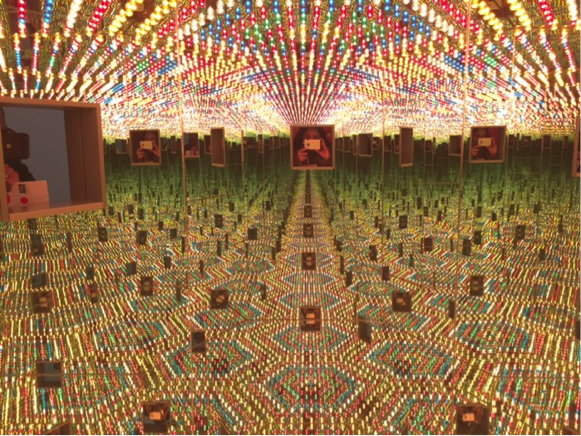Love Forever Chamber, Infinity Mirror Rooms Exhibit, Art Gallery of Ontario, Toronto 2018
Entering the Infinity Mirror Rooms in Kusama’s exhibit at the AGO felt like I had stepped back into a child version of myself and wandered down a rabbit hole into Alice’s psychedelic Wonderland. I lost myself in spectacular fantasy kaleidoscopes of magical mirrors, dizzying fields of lights, peep show chambers, happy pumpkins and infinite dots endlessly reflecting my oneness with her art. I was one small part of the exhibit in each room just as the art became part of my own senses. Kusama’s art got me thinking about yoga, and my work as an educator and social work practitioner. Through all these disciplines, we are called to explore the idea of oneness, suspension of time and space to be truly present, moving beyond individual boundaries to participatory experiences that challenge us to integrate the context.
In yoga, as in meditation, the repetition of breath, postures, and simple mantras can eventually obliterate our mental chatter into infinite seas of calm. Moving us from our own chaotic thought patterns to a quieter canvas. Yoga and mindfulness practices foster an awareness that we are just passing through, guide us to accept that we are reflected back in everything around us, and gently coax the surrender of our ties to particular outcomes. Through mindful interventions like breath focus, body scanning, acceptance of things as they are, and making time for gentle solitude, we can observe our monkey mind without any attachment to its mischief. Even as I witnessed my own hallucinatory visual experience in wandering through Kusama’s work, her skill and commitment in inviting your absolute presence is evident. She is an elder who, like a monk, calls on her audience to detach from their minds and blend into the present moment. Kusama’s art calls us to stop in the middle of repetitive chaos and see ourselves as part of a larger, eternal universe.
“The positives and negatives become one. At that moment, I become obliterated.”
- Yayoi Kusama
Similarly, to build communities or educate learners requires openness, the abandonment of preconceived notions, generous interaction, critical questioning, and a unity with all sentient beings or the environment around us. Looking at photographs of naked bodies covered with dots and blending into the urban New York infrastructure of 1960’s, Kusama’s celebration of all shapes of bodies carrying dots like the wild galaxy above us, challenges the exploitative status quo that covers up the business of war and racism. A field of polka-dotted pumpkins reminds us of the playfulness that we all need, but rarely access, in our daily work. How can we teach social activism or peace strategies without getting caught up in a sense of unfairness or becoming too attached to pain? How do we break through the trauma of our communal narratives of homelessness, poverty, mental and physical illness, food insecurity, violence and other intersectional journeys, and still teach the language of resilience, hope, creativity and solidarity? How do we retain a belief in beauty and suspend our judgments, in accepting and meaningfully responding to events? Looking through a peephole at the “Love Forever” exhibit, and seeing myself reflected back in fields of infinity, I understood Kusama’s artistic response to civil rights, sexual liberation, and the anti-Vietnam war movement. Her utopian desire for love, connectedness, and freedom to address hate, othering, and violent restrictions on liberation. I walked away moved by the resilience of this Asian woman artist who experimented with avant-garde ideas and learned to thrive in a White male-dominated world of art in 1960’s America.
Feeling utterly inspired and satisfied, and quite like the Cheshire Cat, questions multiply and sprout vigorously in my mind. Privileged to be in Kusama’s mad fairyland, I consider the rich qualities studded like jewels in magical fields. How can we each reflect these lessons from Kusama in our own work and/or play?

